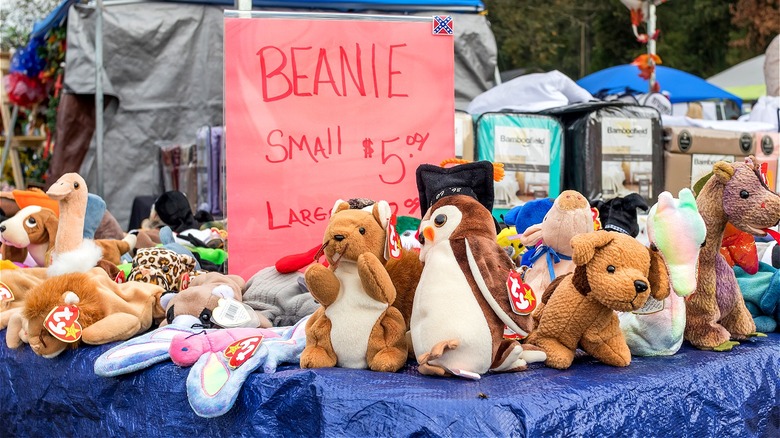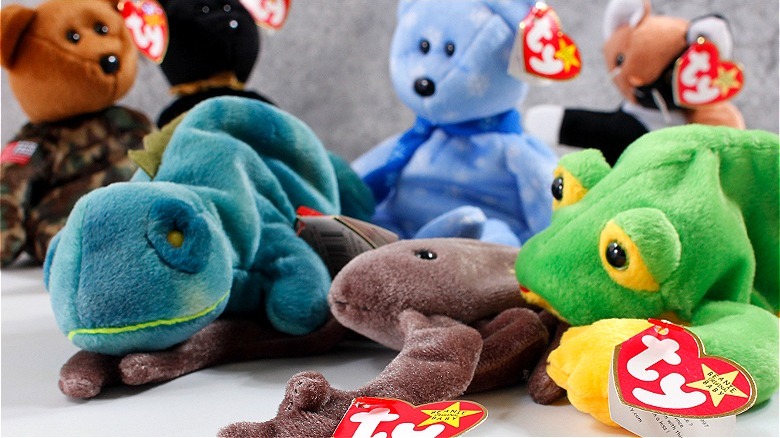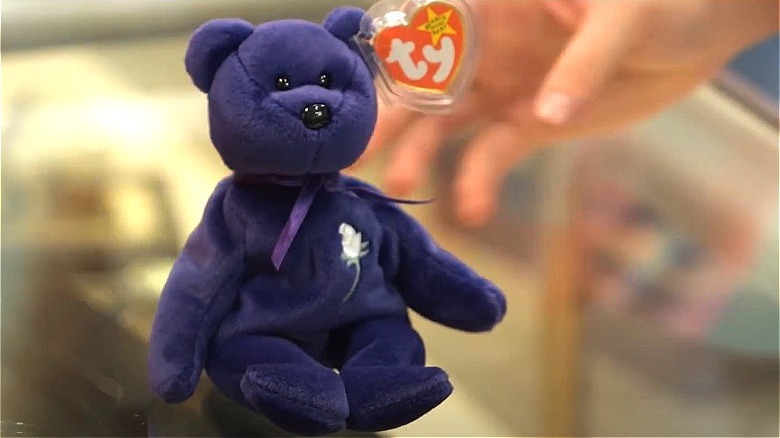The Unexpected Value Of Your Old Beanie Babies Today
Toys make for fun and potentially valuable collectibles; there's nothing new or strange about this. Whether it's a Victorian China doll set, old McDonald's Happy Meal toys that are worth a ton today, or a run of mint-condition, never-removed-from-box G.I. Joe action figures, people are drawn to toy lines for their sentimental value, their sense of design and, yes, sometimes for their monetary worth (see the unexpected value of your old Barbies). But even with all that said, it's still remarkable that a line of plush animals sold with little to no marketing became an asset some people were willing to sink their entire life savings into: the Beanie Baby.
The 1990s Beanie Baby bubble was partly manufactured by savvy supply decisions by the toys' manufacturer Ty Inc., which abruptly retired many of the stuffed animals to create a largely false sense of scarcity. But it was also partly an inexplicable mass fad in the United States, one that saw people spending thousands of dollars to get their hands on $5 toys. At the time, Beanie Babies were the foundation of retirement plans, a point of contention in divorce proceedings, and a boon to the nascent online market. And then, like all bubbles, it burst, leaving families across the world with scores of cuddly but financially worthless toy critters.
That largely holds true today; most Beanie Babies aren't worth much more than their original $5 price tag. However, the market for Beanie Babies hasn't vanished entirely. People still collect them, for their children to play with, as a hobby — and still, in some rare cases, because the particular edition is worth a lot of money.
The older, rarer the Beanie Baby, the more valuable
Beanie Babies were mass-produced, so there are plenty of them around. And most Beanie Babies were widely collected when they were first released, further driving down their value. For those with a big collection who might want to make some money on their beanies, a general rule of thumb for collectors is that the older and rarer the toy, the more valuable it'll be worth. And, if a particular Beanie Baby has been retired, it's probably worth even more.
Take the original nine Beanie Babies, for example: Patti the Platypus, Spot the Dog, Squealer the Pig, Brownie/Cubbie the Bear, Chocolate the Moose, Pinchers the Lobster, Splash the Killer Whale, Legs the Frog, and Flash the Dolphin are all retired, and all come from the earliest days of Ty Inc., well before Beanie Babies became a cultural phenomenon in the '90s. They're hard to get your hands on, and so their value can go as high as $2,000. Animals from the first three generations of the toys can reach those heights or soar even higher. (Similarly, earlier Funko! Pop figures are worth a lot more than recent editions.)
Of course, that depends on their condition, a concern for all Beanie Babies. And even a mint or near-mint Beanie Baby can have some of its value knocked off it by seemingly trivial factors. For example, a mint condition Libearty bear is usually valued around sale price; they were widespread. But a mint condition Libearty with the Summer Olympics tag on it, one of only a few made before Ty Inc. lost the rights to the logo, can fetch you a grand at least. And an erroneous third foot can make Batty the Bat worth almost $150,000.
Limited-edition Beanie Babies have a high value
Not every Beanie Baby is a mass-produced toy churned out on the regular, barring an arbitrarily enforced retirement. There have been many limited-edition Beanie Babies. However, being part of a limited run doesn't automatically make them valuable. For example, the purple Princess bear, issued to commemorate Princess Diana, may be the most iconic Beanie Baby of all, and demand for it was rabid in the late 1990s. But for a limited edition, Ty Inc. made a lot of them, and they're not hard to find these days. While you could list it for the thousands of dollars they sometimes went for in the '90s, it's doubtful you'd find a buyer at that price.
Greater worth can be found in other, more obscure limited Beanie Baby releases. For example, a small number of Chef Robuchon bears were made and handed out to celebrate the opening of a restaurant owned by Ty Inc. founder Ty Warner in 2006. These weren't sold, but presented as gifts to the press covering the opening. A mint-condition Chef Robuchon, with its original case and the invitation to the opening, can be worth up to $8,000.
Other rare hand-out beanies include the Billionaire Bear, made for Ty Inc. employees to celebrate selling $1 billion worth of the toys, and the 253 #1 bears Warner personally signed and presented to his sales reps. For these, their value is high because of their genuine scarcity. Some of these limited editions, like Chef Robuchon, were made after the Beanie Baby bubble had burst, and those who received them may never have considered them after the opening. Many are lost.


